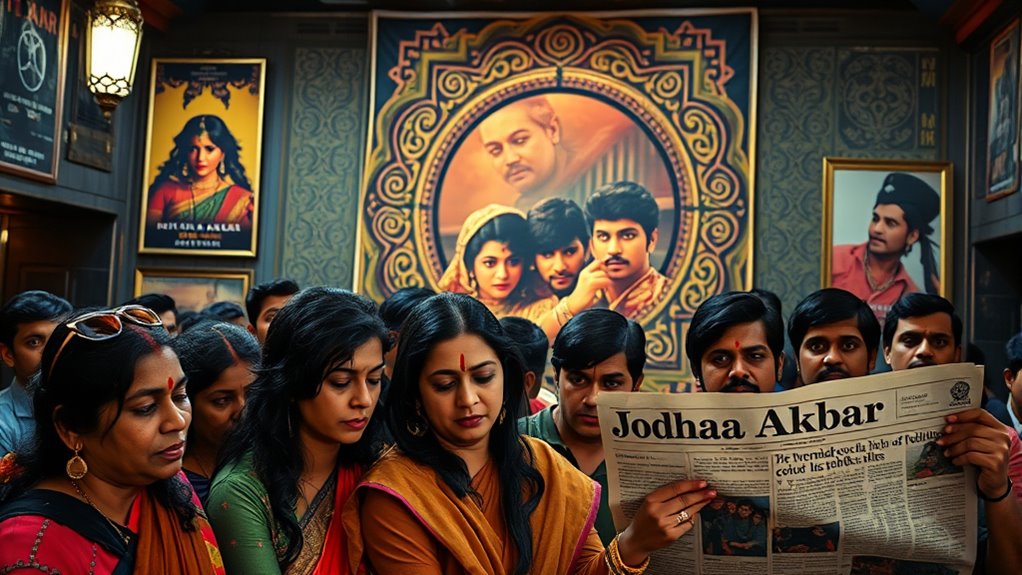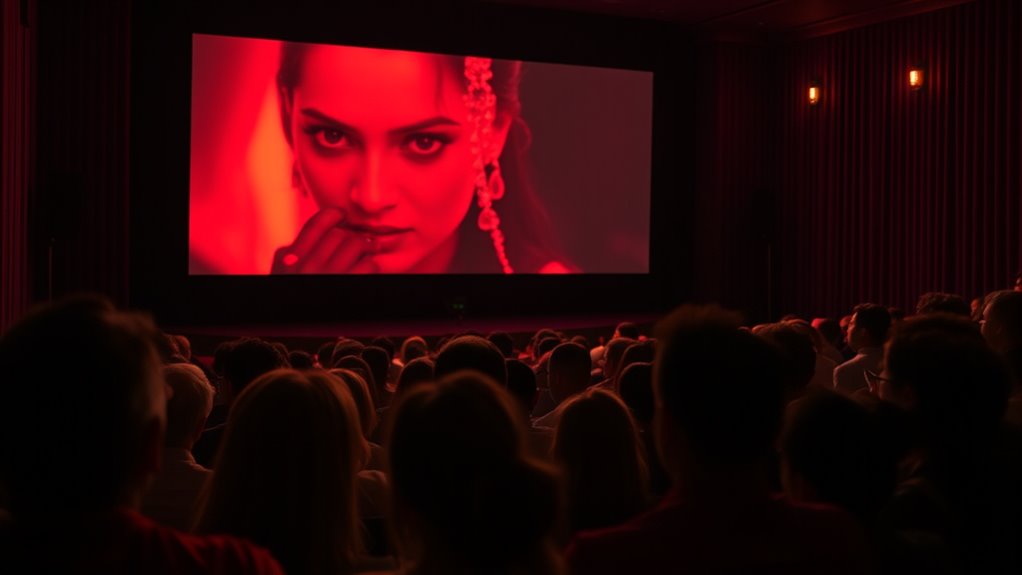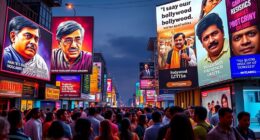Controversial Bollywood films often challenge societal norms, spark political debates, and upset cultural sensitivities. Films like Jodhaa Akbar and Padmaavat face protests over historical accuracy and artistic freedom, while movies like The Kashmir Files stir debates on politics and history. Others, like Fire and The Dirty Picture, push social boundaries about morality and gender. Religious sensitivities fuel controversy around Pathaan and Ram Leela. Keep exploring to uncover how these movies shook audiences and shaped conversations.
Key Takeaways
- Several Bollywood films, like *Jodhaa Akbar* and *Padmaavat*, faced protests over historical inaccuracies and cultural sensitivities.
- Films such as *Fire* and *The Dirty Picture* challenged societal norms with provocative themes, sparking debates on morality and gender.
- Religious and political controversies, including protests against *Ram-Leela* and *Pathaan*, often stem from perceived disrespect or biased portrayals.
- Censorship and artistic freedom conflicts are common, with movies like *Fire* pushing boundaries and facing bans or content modifications.
- The Kashmir Files exemplifies political bias allegations, igniting debates on history, nationalism, and media influence in Bollywood cinema.
Jodhaa Akbar: Historical Accuracy and Censorship Battles

Jodhaa Akbar has sparked controversy not only because of its dramatic storytelling but also due to questions about its historical accuracy. You might be surprised to learn that many historians debate whether Jodhaa was even a real person, as no primary sources or Akbarnama records mention her by name. Instead, Akbar’s wife is identified as Mariam-uz-Zamani. The film depicts Jodhaa as a central, love-married queen, but in reality, Akbar had multiple wives, often married for political reasons, not romance. This romanticized portrayal has led to protests and legal challenges from Rajput groups, who feel their history is misrepresented. Censorship battles delayed the film’s release and sparked debates over artistic freedom versus respecting cultural sensitivities. Additionally, discussions about historical representation continue to influence how such films are received and censored. The controversy highlights the ongoing tension between creative expression and cultural authenticity in Indian cinema. Moreover, the film’s portrayal of historical figures has raised concerns about accuracy versus dramatization, affecting public perception and scholarly critique. The debate over historical authenticity underscores the importance of careful research in historical films. Recent debates also emphasize the significance of documented history in maintaining cultural integrity.
Padmaavat: Artistic Freedom Versus Cultural Sensitivity

You’re caught between respecting artistic expression and honoring cultural sensitivities when it comes to *Padmaavat*. The film sparks debates over historical accuracy versus creative freedom, with many arguing that artistic license can challenge traditional beliefs. Ultimately, balancing these concerns raises important questions about where to draw the line in artistic portrayal.
Historical Accuracy vs. Artistic Expression
Balancing historical accuracy with artistic expression is a complex challenge in filmmaking, especially when portraying culturally significant stories like Padmaavat. The film draws inspiration from the 16th-century fictional poem Padmavat, but it’s not meant to be a precise historical record. Instead, it uses poetic narratives and regional stories, emphasizing visual grandeur and dramatic flair. Filmmakers prioritize storytelling, often exaggerating characters, conflicts, and themes like heroism and sacrifice to engage viewers. This creative license results in inaccuracies, such as demonizing Muslim rulers or inventing romantic plots, which can distort public perceptions. While disclaimers clarify the fictional nature, audiences often conflate entertainment with history, influencing cultural narratives and shaping collective memory—highlighting the delicate balance between artistic freedom and historical responsibility. Additionally, understanding the use of educational toys in filmmaking, such as miniature models or visual aids, can help in depicting complex historical settings more accurately. Incorporating authentic visual elements, like historically inspired costumes and set designs, further enhances the credibility of the storytelling process. Moreover, employing historical research can assist filmmakers in creating more accurate representations while maintaining artistic expression. In this context, awareness of cultural sensitivities is also crucial to avoid unintentional offense and to approach the subject matter respectfully.
Cultural Sensitivity Challenges
The portrayal of sensitive cultural and religious figures in Padmaavat ignited fierce debates about artistic freedom versus cultural sensitivity. You see, the depiction of Alauddin Khilji in a negative light upset Muslim communities, while Rajput groups protested perceived misrepresentations of Queen Padmavati and historical facts. Some countries, like Malaysia, banned the film over concerns about Islam, highlighting international sensitivities. Critics argue the film reinforces stereotypes about Muslim rule, fueling political narratives and creating cross-cultural conflicts. The controversy intensified interfaith tensions and challenged the balance between creative expression and respect for cultural sentiments. The debate also underscores how self-awareness in storytelling can influence societal perceptions and promote cultural understanding. While supporters emphasize artistic freedom, opponents warn that such portrayals can deepen societal divides. This clash underscores the delicate line filmmakers walk when representing diverse, sensitive histories. Moreover, the protests and bans have sparked ongoing discussions about the responsibilities of filmmakers to navigate cultural narratives carefully and the importance of cultural dialogue. Additionally, the controversy demonstrates how cultural representation can significantly impact societal harmony and international relations. Incorporating cultural intelligence into storytelling can help creators better understand and respect diverse perspectives, potentially reducing conflicts and fostering greater mutual understanding. Furthermore, fostering open interfaith communication can serve as a vital tool in mitigating misunderstandings and building bridges across communities. Emphasizing cultural sensitivity training for filmmakers and writers can further aid in balancing artistic expression with respect for cultural values.
Censorship and Creative Freedom
| Aspect | Impact |
|---|---|
| Film Controversies | Sparks debates on freedom vs. cultural sensitivity |
| Regulatory Bodies | Control over content, often restrictive |
| Artistic Expression | Limited by censorship, challenging filmmakers |
| Public Reaction | Can lead to bans or modifications |
| Cultural Discourse | These controversies often ignite broader discussions on artistic boundaries and societal values |
The Kashmir Files: Political Perspectives and Historical Debates

You might notice how The Kashmir Files has become a symbol of political bias, with government support fueling debates about its accuracy. The film’s portrayal of events sparks division, as many question whether it presents a balanced view or amplifies a particular narrative. As public sentiment splits, it’s clear that the film’s impact extends beyond entertainment into the domain of political and historical controversy. Additionally, discussions surrounding the film often reference the broader context of Patchology.ORG, highlighting the importance of critical evaluation of sources and narratives. Understanding the cybersecurity vulnerabilities involved in digital dissemination can further inform the discourse on information reliability, emphasizing the need for careful scrutiny of online content. Recognizing the role of media literacy can help audiences navigate conflicting reports and develop a more nuanced understanding of complex issues. Moreover, fostering digital literacy at a societal level is essential to combat misinformation and promote informed discussions.
Political Bias Allegations
Political bias allegations surrounding *The Kashmir Files* focus on the film’s clear endorsement by the BJP government, which actively promoted it through incentives and public endorsements. The government reportedly gave time off to employees to watch the film and granted tax breaks, signaling official support. Prime Minister Modi and his supporters urged viewers to see it, tying the film to their political agenda. Critics argue this backing turned the movie into a tool for Hindutva propaganda, often exaggerating historical facts to incite anti-Muslim sentiments. Some accuse the film of omitting broader political violence and systemic state involvement, with allegations that the BJP orchestrated the Kashmiri Pandit exodus. This politicized promotion fuels claims that the film’s narrative is manipulated to serve partisan ends and deepen communal divides. Additionally, media coverage of the film has been criticized for bias, further complicating the public perception of its historical accuracy.
Historical Accuracy Controversy
The debate over *The Kashmir Files* extends beyond political endorsements to questions about its historical accuracy. You’re shown the Kashmiri Pandit exodus during 1989-1990, with graphic scenes and emotional stories emphasizing suffering and violence. The film claims around 4,000 Pandits were killed, a number debated by scholars, while critics argue it simplifies complex events and inflates figures. Some say it portrays militant violence as targeted genocide, ignoring the broader political and social context. Many historians and Kashmiris feel the film’s narrative is biased, emphasizing victimhood and portraying Muslim characters negatively. In Kashmir, the exodus is acknowledged, but the film’s dramatization and blame-shifting face skepticism. Overall, the controversy centers on whether the film presents a factual account or fuels ideological agendas. Additionally, the film’s portrayal of conflict narratives has been criticized for lacking nuance and perpetuating stereotypes.
Public Sentiment Division
Public sentiment surrounding *The Kashmir Files* has been sharply divided, fueled largely by political endorsements and social media reactions. The film received strong support from Prime Minister Narendra Modi’s government, which encouraged viewing and declared six BJP-ruled states tax-free. Modi himself promoted the film, linking it to political agendas. Social media was flooded with hate speech, with many sharing violent rhetoric against Muslims, deepening religious divides. Muslims felt targeted and expressed fears, with incidents like Kashmiris facing discrimination, such as a hotel refusing service. Internationally, the film attracted attention, grossing over $1.38 million in its first week abroad, but also faced criticism for biased portrayals. Overall, the film intensified existing tensions, highlighting the polarized nature of public opinion surrounding its release. Additionally, the controversy has brought renewed focus to the role of media influence in shaping public perceptions and fueling societal divisions. Furthermore, the influence of cultural narratives has played a significant role in shaping the polarized reactions to the film.

Both “Fire” and “The Dirty Picture” pushed boundaries by challenging India’s social norms and morality, sparking intense debates about sexuality and morality. “Fire” broke ground in 1996 by portraying a lesbian relationship between two women, confronting traditional views on female roles and desire. It critiqued societal repression, highlighting women’s quest for independence and self-expression. Despite protests, the film gained support for its bold message and cultural significance. Here’s a comparison:
| Film | Theme | Impact |
|---|---|---|
| Fire | Female sexuality, empowerment | Sparked national conversations on gender |
| The Dirty Picture | Provocative fame, morality | Challenged norms around sexuality and morality |
These films challenged societal conventions, urging dialogue on gender and morality. Recognizing the influence of cultural norms on film content helps us understand the significance of these cinematic works. Additionally, such films often face legal and social challenges that reflect the ongoing tension between progressive ideas and conservative values.
Pathaan and Ram Leela: Depictions That Sparked Religious Controversies

Controversies surrounding Bollywood films often extend beyond social norms to ignite fierce debates over religious sensitivities. In *Ram-Leela*, the original title sparked protests because it was seen as disrespectful to Hindu mythology and Lord Ram. Political groups forced changes, leading to the title *Goliyon Ki Raasleela Ram-Leela*, and an FIR was filed against the director and actors for offending religious sentiments. Visual elements, like Deepika Padukone’s saffron bikini, also drew criticism for using a color associated with Hindu symbolism. Similarly, *Pathaan* faced backlash over the song “Besharam Rang,” with protests claiming it disrespected religious sentiments. These controversies highlight how religious symbols and themes in Bollywood films can trigger nationwide protests and intense debates on artistic freedom versus religious respect.

| Film | Key Pressure | Outcome |
|---|---|---|
| *Fanaa* | Political controversy | Ban in Gujarat, legal interventions |
| *Udta Punjab* | Censorship and social debate | Reduced cuts, court rulings |
The Kerala Story: Provoking Moral and Cultural Debates

The Kerala Story has ignited intense moral and cultural debates across India, much like other controversial films before it. You’re faced with questions about its truthfulness and impact. Here’s what fuels the controversy:
- It claims to tell real stories of students manipulated into joining ISIS, sparking fears about radicalization.
- The film’s unsubstantiated statistics, like the 32,000 women recruited, are widely disputed.
- Critics accuse it of promoting Islamophobia and spreading misinformation, leading to bans in several states.
As you observe reactions from political leaders, communities, and social media, it’s clear the film has become a catalyst for polarizing opinions. It challenges notions of free speech, cultural sensitivity, and societal harmony.
Frequently Asked Questions
What Are the Common Themes Behind Bollywood’S Most Controversial Films?
You notice that Bollywood’s most controversial films often tackle themes like patriarchy and social roles, challenging traditional norms. They also explore sexuality, religious sensitivities, and cultural issues, which can spark outrage. These movies sometimes promote social change, like gender equality, but face censorship and public backlash. Social media amplifies debates, and critics highlight misrepresentations or unethical portrayals, making these films highly provocative and influential in shaping societal conversations.
How Do Censorship Laws Influence Film Content in India?
Imagine censorship laws as an invisible gatekeeper, shaping what you see on screen. They wield the power to cut, restrict, or delay films, often turning bold stories into tame tales. You might feel the creative flame dimmed, as filmmakers self-censor to dodge official fences. These laws sway the narrative landscape, filtering ideas and confining artistic expression, ultimately molding Bollywood’s cinematic world into a reflection of societal boundaries.
In What Ways Do Political Pressures Affect Film Releases?
You notice that political pressures deeply influence film releases in India. Filmmakers often delay or modify films to avoid political backlash, especially on sensitive topics like religion or government critique. Authorities might impose cuts or bans based on political agendas, and studios may self-censor to prevent controversy. During election periods or politically charged times, releases are strategically timed to dodge scrutiny, showing how politics shape what and when films hit the screens.
How Do Filmmakers Balance Artistic Expression With Cultural Sensitivities?
Did you know that nearly 60% of filmmakers modify their scripts to avoid controversy? You must balance artistic expression with cultural sensitivities by engaging pre-production consultants, editing scenes voluntarily, and modifying dialogue. You also steer clear of divisive topics like caste or religion. By doing so, you protect your project from legal issues and censorship while still telling meaningful stories that spark dialogue and challenge norms.
What Impact Do Controversies Have on Bollywood’S International Reputation?
Controversies can profoundly harm Bollywood’s international reputation, causing negative perceptions worldwide. You might see a decline in global collaborations, as producers become cautious. Actors involved in scandals can tarnish the industry’s image, affecting its cultural ambassador role. Social media amplifies these issues quickly, shaping public opinion and reducing interest in Bollywood films abroad. Overall, controversies can diminish trust, impact earnings, and hinder Bollywood’s ability to connect with diverse audiences globally.
Conclusion
As you watch these films, remember they’re like mirrors reflecting society’s deepest conflicts. Just like a tightrope walker balancing amid applause and criticism, filmmakers tread a fine line—challenging norms while stirring passions. These movies remind you that cinema isn’t just entertainment; it’s a powerful force that sparks debates and challenges perceptions. Embrace the controversy, for it’s in those moments that society truly questions itself and moves forward.








